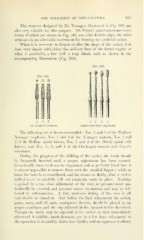Page 663 - My FlipBook
P. 663
THE OPERATION OF IMPLANTATION. 661
The reamers designed by Dr. Younger, illustrated in Fig. 589, are
also very suitable for this purpose. Dr. Cryer's spiral osteotome—two
forms of which are shown in Fig. 587, one with dentate edges the other
without—is an admirable instrument for forming the artificial socket.
When it is necessary to deepen or alter the shape of the socket, it is
done very simply with either the ordinary burs of the dental engine or
what is preferable, a bur with a long shank such as shown in the
accompanying illustration (Fig. 590).
Fig. 590.
12 3 4
Dr. Younger s reamers. Engine burs with long sliank.
The following are to be recommended : Nos. 1 and 3 of the "Walker-
Younger trephines, Nos. 1 and 3 of the Younger reamers, Nos. 1 and
2 of the Rollins spiral knives, Nos. 1 and 2 of the Ottofy spiral crib
knives, and Nos. 1, 3, and 4 of the Ottolengui reamers and Cryer's
osteotome.
During the progress of the drilling of the socket, the tooth should
be frequently inserted until a proper adjustment has been secured.
Occasionally these teeth can be implanted and so perfectly fitted that it
is almost impossible to remove them with the unaided fingers ; while at
times the bone is so cancellated, and the tissues so flabby, that a socket
drilled never so carefully will not retain the tooth in place. Nothing
is gained by a too close adjustment of the root, as pressure must un-
doubtedly be exerted, and pressure causes resorption, and may be fol-
lowed by inflammation. A fair, moderate fitting of the root is all
that should be aimed at. Just before the final adjustment the socket,
gums, tooth, and all parts contiguous thereto, should be placed in an
aseptic condition and the cap adjusted in the manner before described.
Though the tooth may be adjusted to its socket so that immediately
afterward it exhiV)its much firmness, yet in a few days subsequent to
the operation it invariably shows less rigidity and an ajjparent tendency


